The same HyacinthMacabre from reddit, twitch, and Pinterest. I play D&D and other TTRPGs many times per week and love theorycrafting.
Don't wanna be here? Send us removal request.
Text

Cover illustration I did for a TTRPG set in the Thirty Years’ War, based on real events. You can get it here (and it’s free 👏)
772 notes
·
View notes
Photo
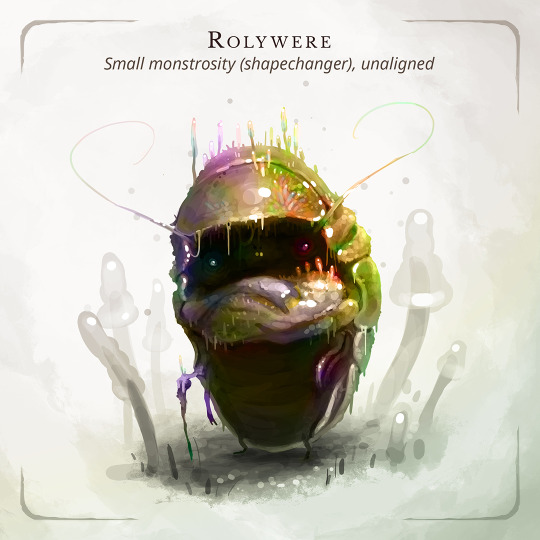

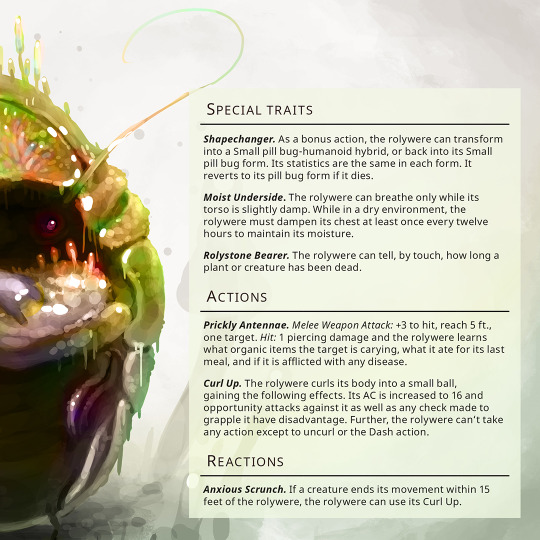
Rolywere – Small monstrosity, unaligned
There are secrets whispered in the slow and gentle rot of loam, heard only in hidden places of ancient shade, beneath rock unmoved for aeons. The rolywere is birthed and empowered by these whispers, awakened to the world beyond that shade, and yet its ambition remains small; it wishes only to crawl, to smell, to remain safe and hidden and damp. The rolywere‘s secrets, though intelligible only to it, are precious, and so it seeks out an object to pour them into, an investiture through which the object grows in power as the caked earth and moss of long years accumulate over it. The item is often one of great personal significance to the rolywere - perhaps a desiccated potato or mouldy stick, perhaps a mighty artefact long-forgotten, and these treasures are much sought after by those callous enough to take them.
This creature was made in collaboration with Conflux Creatures ❤️
🔮 If you like my work, kindly consider to support me on Patreon to gain access to monster pages, tokens & artwork of 200+ of quirky creatures, items and potions.
88 notes
·
View notes
Photo
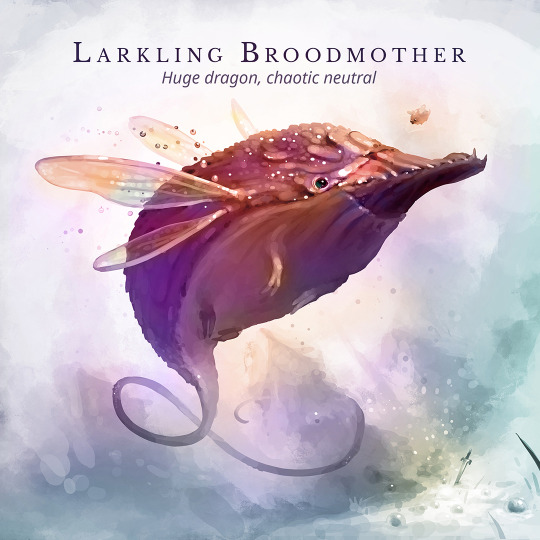
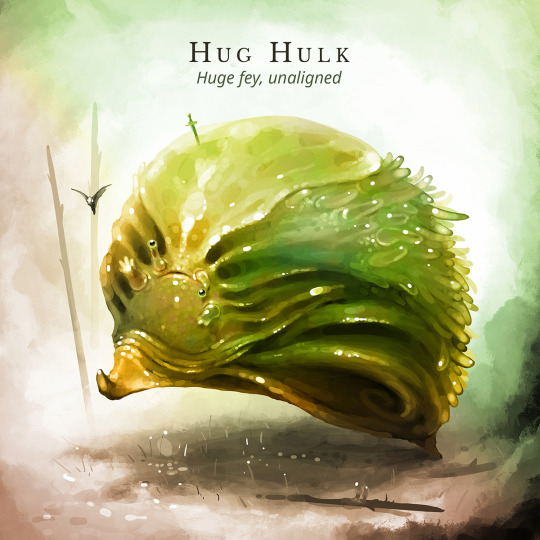

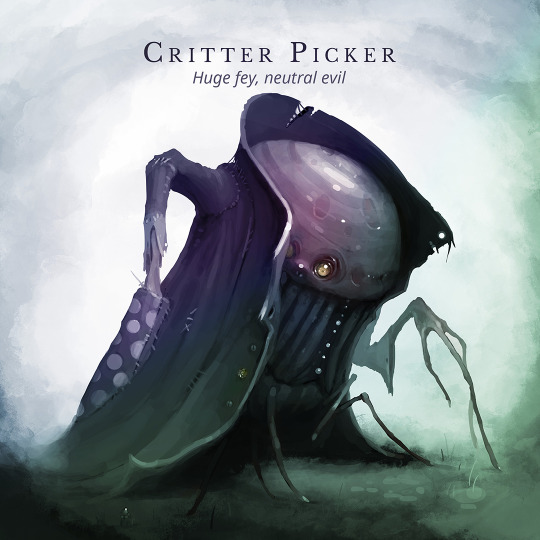

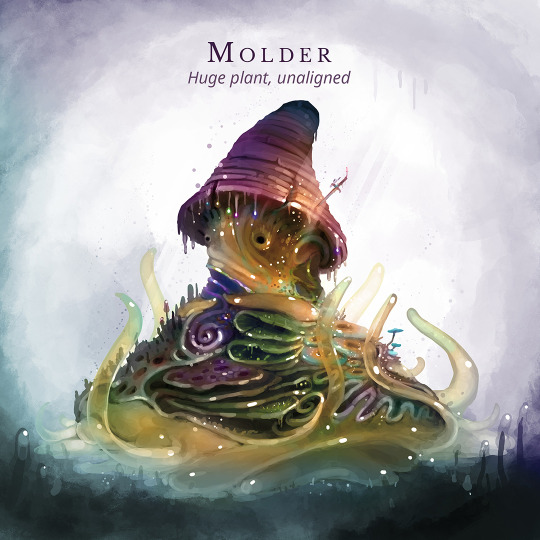
Huge Monsters!
here is a small selection of the huge creatures I’m creating!
I release them each month over at my Patreon and got 25 so far. So in case you enjoy my work and need a few bosses for your campaign, kindly consider to support me. The huge creatures are available to all my patrons - no matter which tier<3
114 notes
·
View notes
Text

Replaying Curse of Strahd (for the 3rd time), so I had to redraw the bae for some token art
222 notes
·
View notes
Text
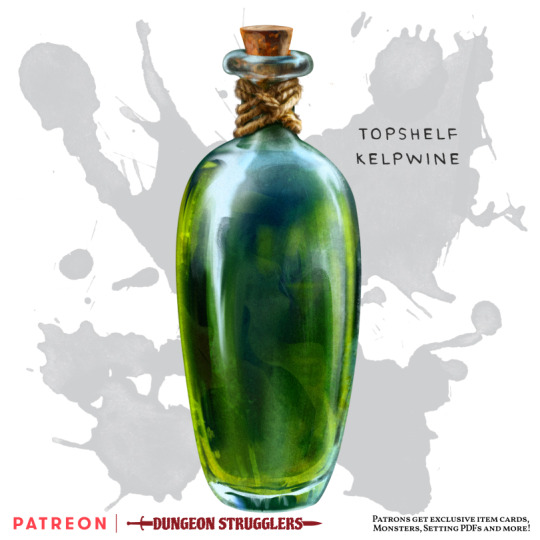
✨New item!✨ Topshelf Kelpwine Potion, uncommon
This sea glass bottle contains 1d4 + 1 servings of light green liquid with a slightly syrupy viscosity. It has a subtly salty alcoholic bite, with a grassy aftertaste. For 1 hour after you drink a serving of this beverage, you ignore the effects of the first 3 levels of exhaustion and your hit point maximum and current hit points increase by 5. Each time you drink the brew, you manifest a random harmless side effect for the duration. Roll a d6 to determine the effect.
Your skin becomes rubbery, and your movements produce a subtle squeaking noise.
You begin sweating profusely, and it smells like seawater.
Your skin turns a mottled, brownish-green.
Seabirds within 100 feet of you will try to land on your head.
Sea lice infest your hair.
Crabs within 100 feet of you will line up to give you a high five. The crabs aren’t real.
Sigourney’s special brew, fortified to keep you going on those hard nights at sea.
- 🖌🎨 Like our work? Consider supporting us on Patreon and gain access to the hi-resolution art for over 170 magic items, item cards and card packs, beautiful creature art and stat blocks and setting pdfs with narrative hooks and unique lore!🧙♂️
📜 Credit. Art and design by us: the Dungeon Strugglers. Please credit us if you repost elsewhere.
261 notes
·
View notes
Photo
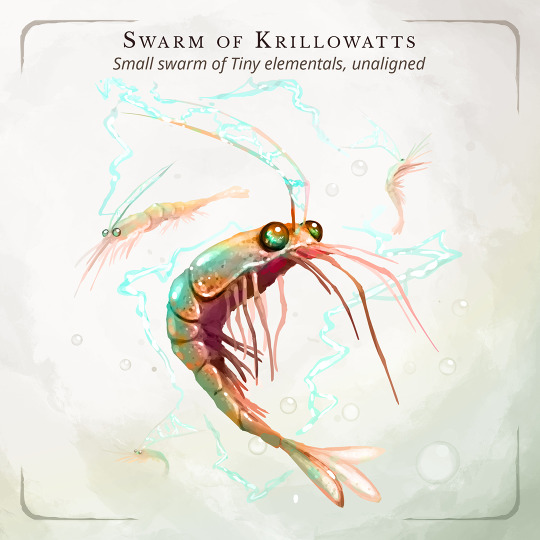
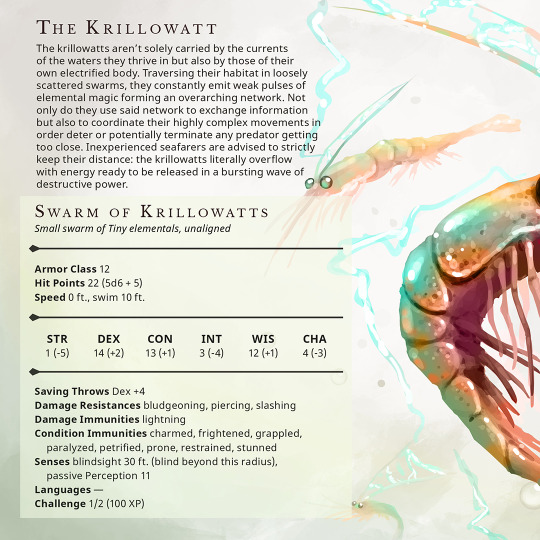

Krillowatts – Small swarm of Tiny elementals, unaligned
The krillowatts aren’t solely carried by the currents of the waters they thrive in but also by those of their own electrified body. Traversing their habitat in loosely scattered swarms, they constantly emit weak pulses of elemental magic forming an overarching network. Not only do they use said network to exchange information but also to coordinate their highly complex movements in order deter or potentially terminate any predator getting too close. Inexperienced seafarers are advised to strictly keep their distance: the krillowatts literally overflow with energy ready to be released in a bursting wave of destructive power.
🔮 If you like my work, kindly consider to support me on Patreon to gain access to monster pages, tokens & artwork of 200+ of quirky creatures, items and potions.
711 notes
·
View notes
Photo
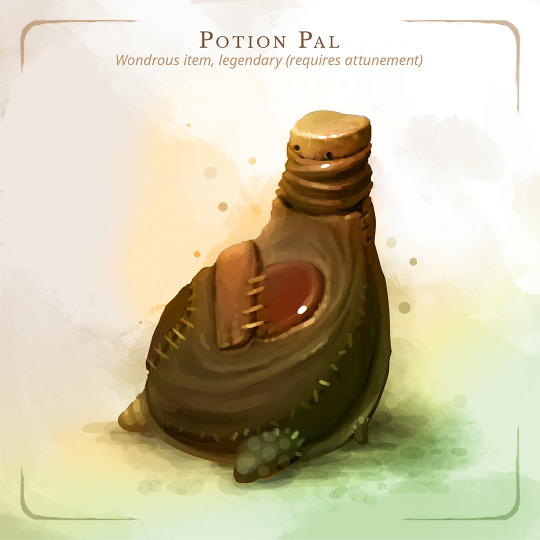
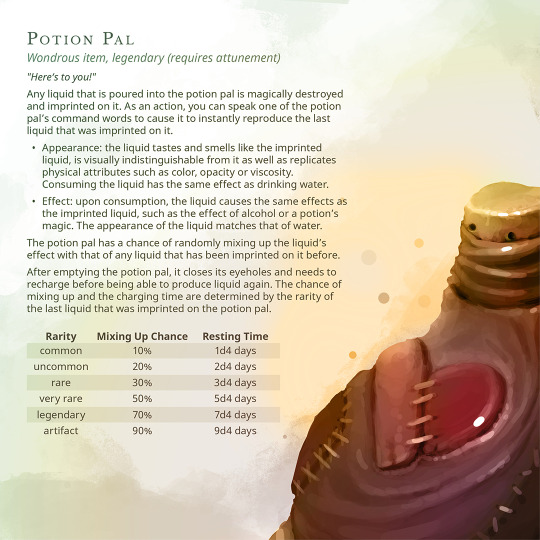
Potion Pal – Wondrous item, legendary
Here’s to you!
🔮 If you like my work, kindly consider to support me on Patreon to gain access to monster pages, tokens & artwork of 200+ of quirky creatures, items and potions.
186 notes
·
View notes
Text
Late at night musing about bad D&D experiences. I’m so tempted to write them out and anonymously post them.
Then I remember I’m a quirky character designer and any grievances I have would require explaining the situation in such a way that it would make it patently obvious it’s me.
Like a few of my character concepts (unrelated to how I felt about the campaign they were played in):
*Dall Sheep Faun/Satyr named Shirleigh - Monk with hoof attack. Says punchy punch punch every time she used flurry of blows.
*Halfling Ranger where I took the Knight background and turned it into a Girl Scout leader and brought part of my troop to Barovia with me.
*Bricklayer Shifter Barbarian I called Barb who used bricks to fight and had the ghost of old bullies appear whenever she used her feature who belittled her made her angry enough to rage.
Gnome Sorcerer where I had absolutely shit stats (highest was a single 12) and so I decided to go with Wild Magic — the DM allowed me to reroll but I was like ooooh let’s playing with completely shit stats and yes I regretted it later.
And then I really think about the “horror” of the stories and I realize that it’s mostly my perception of how things went down — or my impatience — or the quirky, weird character I rolled and how I was annoyed with having to make decisions for that character which had entirely nothing to do with the rest of the campaign.
If I’m brutally honest with myself — they weren’t horrible or terrible experiences. They were often differences in expectation. My expectations not always the same as others (sometimes unfairly in certain areas like speed of combat, style of roleplaying, and adherence to plot).
Some situations where I didn’t fit right (all were games in 5e and are actually all different groups! I feel kinda like a serial D&D group dater.):
*Once I was in a game which was very combat-focused and there was roleplaying but clearly the only one wanting to wax and wane about things between combats was just me. They were all enjoying the game and were fine with how it went. I didn’t fit there. So I left.
*My initial expectations of a game (small and local) changed when it went online due to Covid-19 as players dropped out and new ones came in. The character I designed for a small, friends-only game didn’t apply for a bigger one where people dropped in and out. Changing my character didn’t fix the disconnect I felt. So I left.
*I joined a game where there were many newbies and was excited to assist the DM with teaching how to play (I’ve run games as a DM for newbies before and love introducing people to D&D or other TTRPGs) only I realised after several sessions that nobody wanted to learn to play they just waited for me to solve everything and would only say anything when I pushed them to speak up. I didn’t want to have to keep doing that as I felt like I was DMing.
*Joined a game where the DM wanted to stream and it became apparent that the rule set was so optional as to be non-existent. That wasn’t my expectation and so I withdrew.
*I like a game with combat and build my character to be effective (curse myself for that stupid sorcerer). So a game without some kind of combat (or at least narrative tension and deeds that require rolls) is very boring for me. I was in one game where we did not have a single roll — that would affect the outcome of the story — for four sessions. Those were 3 hour sessions apiece. It reminded me too much of the roleplay chats I did on IRC in internet taverns. We learned nothing, did nothing, solved nothing, and basically on that fifth session we carried on as if those 4 sessions didn’t happen.
Oof. Okay so I complained a little bit in this post. It still was entirely my expectations and mine were contrary to what the group wanted. The heavy combatters wanted to combat. The heavy roleplayers wanted to roleplay. And all of that is perfectly fine for playing a game of D&D. How they all play is entirely valid!
The rules light game? Well it’s valid too (but should probably have used a different rule system like Fate or something).
For these games I just didn’t fit in.
I do fit in with my current group. They mix combat with roleplaying. Plot is not ignored. We design our characters around one another so nobody really overlaps in skill sets. I’ve had many sessions where my character has not shown up — and still been wholly engaged in what is going on with the other characters because it matters what happens to them and whatever they do affects the outcome of the story. I mean I still took notes!
I wish I could share these sessions with the world. But I think that’s the point of a good group that works well — you feel blessed to be a part of it and are so engaged that you want others to be a part of it too. (Don’t invite too many! That can kill a game.)
Thinking with fondness on the good groups is nice way to end this. It’s not bad having expectations, but it’s not good when you commandeer a game to conform to yours if that’s not what the group wants. In cases like that — it’s time to accept or move on.
0 notes
Note
Any ideas for filling out curiosities on a world map? Stuff like dungeons, camps or other oddities that can be marked at a specific place and encountered as the party travels. Or something like the route of a traveling npc that the party can cross paths with. Really whatever. I just like making premade world maps but can never figure out what to fill the space with.

DM tip: Cartography 101
Thanks so much for writing in, dear mapmaker, as you’ve given me a chance to talk about something I’ve been meaning to get around to for a while. I want you to know that I WILL get to your question, I just need to lay out some methodology first.
When I was a younger Dungeonmaster, I used to spend a lot of time drawing maps, but the campaigns I ran on them always seemed to fall apart. It took me a long while to learn that as much as aimless creation a worthwhile persuit, I was jumping the gun, putting a lot of effort into creating a world without an idea of the story I was going to tell in it, That’s why, in my opinion, creating a map is always a step that should come AFTER you’ve decided on the important bones of the story you’re going to tell, that way you can fit your creation to your needs rather than trying to every eventuality and trying to map out an entire planet while your campaign is a mostly linear affair that takes place in one city and the surrounding hinterlands.
Lets look at the different uses for a map, regardless of the story its attached to:
A map is a tiny sliver of an imaginary world,and helps the audience get immersed in that world by helping to build verisimilitude: the feeling that the locations mentioned in the story are real because they exist in relation to other places. This likewise gives the reader an understanding of where things are in relation to eachother, orienting themselves in an unfamiliar geography and helping to tie information they know into a larger context.
A map is a tool for storytellers, gamers, and characters, letting them know how long it might take them to get to a location, how difficult the journey might be, and what they might face along the way. There’s also an element of game design to this, you want your heroes to face challenges, so you put difficult things between them and their goals, and see how they react.
A map facilitates story, with nature largely deciding the arrangement of prosperous settlements, the division between kingdoms, and the formation of societies. Naturally you should tailor your map to the story you’re going to be telling, both in using geography as a “setup” for the history of your world, and as a reflecting what’s going on in the plot by the temperment of the regions the characters are moving through.
Finally, there’s one last utility for a map, but this only exists in games with an “open world” element where the players are deciding on their own direction:
A map hosts a bevy of plot hooks, names and little details that draw the party’s attention and curiosity, asking questions like “What’s the story behind that?”, or “What do you think we’d find there?”. These are generally enough of a heading to get the heroes to head out into the unknown, and encourage them to ask things about the world.
Below the cut I’m going to share my system for turning a story into a map, and then how to fill that map up with extraneous options. Brace yourselves, We’re going to use one from a recent campaign of mine as an example.
Keep reading
363 notes
·
View notes
Text
Fun little thing about medieval medicine.
So there’s this old German remedy for getting rid of boils. A mix of eggshells, egg whites, and sulfur rubbed into the boil while reciting the incantation and saying five Paternosters. And according to my prof’s friend (a doctor), it’s all very sensible. The eggshells abrade the skin so the sulfur can sink in and fry the boil. The egg white forms a flexible protective barrier. The incantation and prayers are important because you need to rub it in for a certain amount of time.
It’s easy to take the magic words as superstition, but they’re important.
146K notes
·
View notes
Photo

a vintage fashion ad, verily based on J.C. Leyendecker’s work – but it’s orcs now.
12K notes
·
View notes
Text
@that-gay-jedi requested that i talk some about material conditions and their effect on worldbuilding so here's something I'm thinking about
One area where the conditions of day to day life never seem to be fully considered in their impacts on the worldbuilding: magic systems.
I'd have to do more research to support this theory, but I think that this is one of the major ways that D&D has shaped how we Do Worldbuilding in fantasy. Most magic systems, in the way they are shown to us, have a lot of very combat-focused applications. Even if it's not all fireballs, lightning bolts, and more classic D&D wizard type stuff, physical/elemental type magic is explored from the angle of "how do I hurt/kill people with this" or "how do I destroy things with this"
But. If you're in a roughly pre-industrial fantasy world, and a portion of the population that's at all significant has magic, or can learn magic, that affects the natural world, the oldest and most widespread type of magic or method of using magic likely isn't going to be for warfare, and even when writers question the combat-centered magic, they usually go for like, exploring how magic is incorporated into the arts or something
Which is great. But in most pre-industrial societies, like 90% of the population is rural farmers. What I'm saying is, where is the farm magic.
The first spells to be developed, the oldest and most well-known spells, should really be like this:
banish slug
repel frost
corral
loosen dirt
uproot
magic scythe
separate chaff
repair horse
castrate bull
deworm
summon scarecrow
peel sheep
direct moisture
What farmer even today wouldn't find loads of uses for magic? Charms that keep patches of ground above freezing. Magical explosions that disseminate seeds instantly all over your fields. Shade spells to protect your plants from beating sun.
If magic can summon demons or familiars or make constructs to do stuff for you, you bet your ass that stuff was used by farmers long before it was ever used for fighting. The most culturally important use of necromancers isn't creating soldiers to form undead armies, it's reanimating your dead mule so he can still pull your plow. Farmer warlocks will summon demons from hell to haul manure for them.
If you have wizards in a fancy wizard private school learning how to create a shield of frost, that knowledge had to come from somewhere, and the answer is probably thousands of years of farmer wizards learning how to magically protect their crops from extreme heat and cold.
I want to see side notes in worldbuilding about how every spell used for combat is basically a repurposed farming spell.
This spell for summoning a magical suit of spectral armor that shatters weapons? Yeah, that was originally developed for chickens so foxes would shatter their teeth when they tried to bite them. It was used for centuries before someone thought of trying it on a person.
6K notes
·
View notes
Text
I think we need to take the “what if the conventional monster was friendly?” thing in fantasy worldbuilding further. “What if the dragon was friendly?” and “what if the orcs across the valley were friendly?” are well and good, but I’m thinking more like “what if the animated skeletons in the local graveyard were friendly?”
I think with the animated skeletons in particular the key is to play up their separation from the living in a way that’s still kinda creepy, but in an odd way rather than a horrific way. Something like:
Animated skeletons are explicitly not just skeleton versions of the living people their bones came from, and in fact don’t seem to have much in the way of individual identity – or, at least, if they do, they don’t express it in the way that humans do.
They aren’t impaired by the loss of individual bones – including the skull! – and can freely swap bones among themselves. The same pile of loose bones won’t always animate into the same number or configuration of skeletons, nor does having more available bones necessarily translate into more skeletons.
Consequently, questions like “how many skeletons are there?” are difficult to answer.
Animated skeletons generally seem to understand both spoken and written languages, but don’t have much capacity for producing language; they don’t speak or write, and their capacity for signing is limited to stuff like nodding or shaking their head for “yes” or “no“, pointing to indicate objects or directions, etc.
In spite of this, they appear to be able to communicate complex information and ideas amongst themselves, but it happens via some undetectable, (presumably) non-language-based medium.
Their otherwise limited expressive capacity notwithstanding, skeleton “culture” (if that’s the word for it) is very big on making music. Instruments and sheet music are among the few material goods that skeletons value, though the former are typically limited to those that can be operated without breath.
(This generally means percussion and strings. Wind instruments that can be operated without breath are an occasional feature; pipe organs are a big deal in those skeleton communities that can get their phalanges on them, as are a modified form of bagpipes, operated by two-skeleton teams where one plays the music and the other inflates the bag with a portable bellows.)
Apart from music, skeletons are mostly into repetitive manual labour, though exclusively on a volunteer basis, as they’re uninterested in payment and will simply collapse into inanimate piles of bones if coerced. If you want a skeleton to do something for you, be prepared to explain why, in detail, to a silent, motionless, and expressionless audience.
Skeletons are notably more likely to heed a request from a priest or religious scholar than from laypersons. There are a lot of theories as to why this is; the skeletons themselves are disinclined to comment.
A skeleton with nothing better to do may squat like a gargoyle near some well-trafficked location and observe local goings-on, remaining motionless apart from turning its skull toward points of interest for days or weeks on end. It’s generally considered polite not to draw attention to their presence.
12K notes
·
View notes
Text
Worldbuilding stuff:
If your story has an idle nobility class, their culture shouldn't just be different from the general population, it should be an over-the-top caricature of the common folks' culture. Whatever the population generally agrees is ideal, fair, admirable, or good, the nobility will take into stupid extremes.
Contrary to the beliefs of many, people are actually not at all happy when they're idle - a person with no assigned task or duty will go out of their way to come up with one. And all around the world, whenever there's been an upper class with nothing to do, they've started to compete with each other over stupid shit, but always stupid shit that the culture they live in considers positive qualities.
From the noblemen in Europe challenging each other to a possibly lethal duel over insulting someone's hat, to a Chinese noblewoman being moved to tears by the beauty of someone's calligraphy, bored elites everywhere have always wanted to outdo each other in their expressions of possessing all the noble traits that this culture in particular holds in value.
You can, and should, use this as a way to highlight what the actual values of this society is. In a setting where being religious is held as an admirable trait, there is nobility coming up with new ways to one-up each other in their expressions of worship. Society that values art and music will have them competing over who hires the most artists, and who employs the most talented musicians. Aggressive, war-like people will have fuels to the fucking death over a stupid hat.
Literally anything can be competed in, and bored people with far too much time and money in their hands will become competitive over the most ridiculous things. This isn't just an useful tool in worldbuilding, but also a fun one.
38K notes
·
View notes
Photo
The pike reminds me of when we would always buy 10 foot poles in 2e D&D. And we would use them like canes to assist the sight-impaired. All so that we didn’t die from traps. Now I have this image in my mind of common folk in the D&D worlds and how they could tell someone was an adventurer simply because they would have a 10 foot pole sticking out of their backpack.

23K notes
·
View notes
Text
EVERYONE STOP AND LOOK AT THIS
Have you ever heard of Shaun Keenan? Probably not, but you have now.
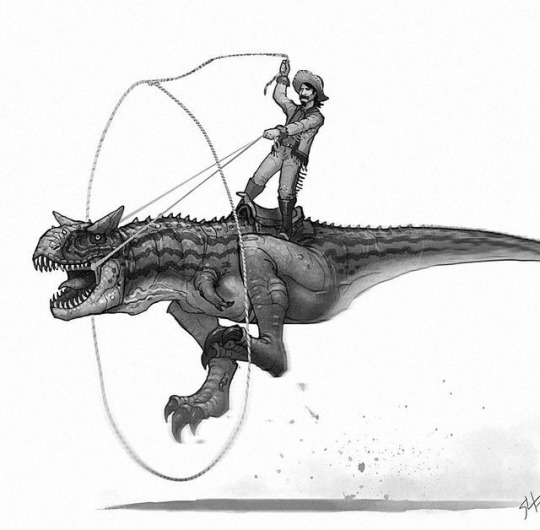
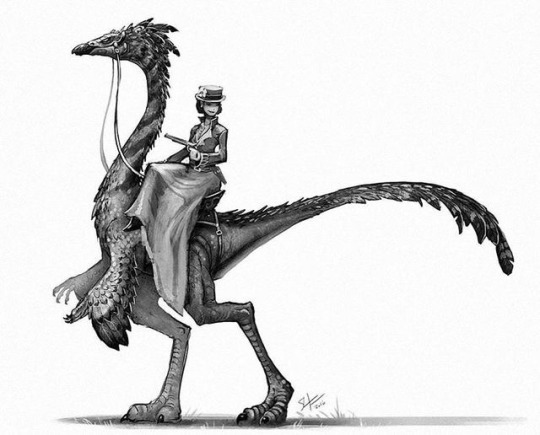
Amazing art of dinosaurs in the wild American West? Yes please!


There’s so many he’s done and they’re all just the best aesthetic.


What I never knew I needed but a void has definitely been filled.
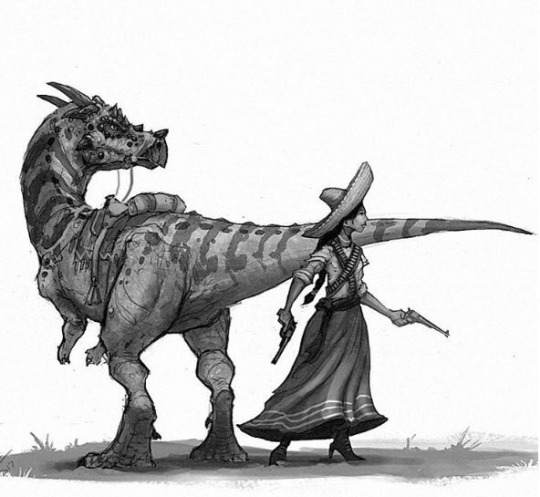

Go to his website and give some support!
http://shaunkeenan.com/
159K notes
·
View notes
Text
Table of Weapon Upgrades
The local weapon-smith appreciates you slaying that swarm of Dire Lungfish that was threatening their shop, and to thank you they want to upgrade your weapon! I’m sure they know what they’re doing, go ahead and roll d50 without reading the whole table
Glowing: emits harmless light when the command word is spoken
Anarchic: extra 2d6 against Law
Axiomatic: extra 2d6 against Chaos
Holy: extra 2d6 against Evil
Unholy: extra 2d6 against Good
Decisive: extra 2d6 against Neutral
Vorpal: if you roll a 20 while attacking, the target loses a head
Returning: flies back into the hand of the user when thrown
Ghostly: able to affect incorporeal creatures and objects
Silent: makes no noise when used
Invisible
___-Bane: extra 2d6 damage against a particular race/species/type (DM’s choice, or https://randomencounters.tumblr.com/post/631073167702687744/)
Silvered: can damage some creatures immune to most non-magical weapons
Dancing: can hover, attacking on its own
Scarring: successful attacks leave permanent and distinctive marks
Acid: extra 1d6 Acid damage on successful attack
Flaming: extra 1d6 Fire damage on successful attack
Forceful: extra 1d6 Force damage on successful attack
Frost: extra 1d6 Cold damage on successful attack
Shock: extra 1d6 Lightning damage on successful attack
Thundering: extra 1d6 Thunder damage on successful attack OR causes the effect Deafened
Mind: extra 1d6 Psychic damage on successful attack OR the damage can be applied as a penalty to Wisdom or Knowledge scores (d10 rounds)
Poisoned: extra 1d6 Poison damage on successful attack OR causes the effect Nauseated; wounds take twice as long to heal
Spiked: extra 1d6 Piercing damage on successful attack
Sharp: extra 1d6 Slashing damage on successful attack
Weighted: extra 1d6 Bludgeon damage on successful attack
Glorious: extra 1d6 Radiant damage on successful attack
Vile: extra 1d6 Necrotic damage on successful attack
Shiny: causes the effect Blinded
Paralyzing: causes the effect Paralyzed
Draining: each successful attack causes the target a level of Exhaustion
Prejudiced: glows in the presence of a particular race/species (DM’s choice, or https://randomencounters.tumblr.com/post/631073167702687744/)
Gem-Encrusted: double standard value
Scary: adds 1d6 on Intimidation checks when equipped
Really Cool: adds 1d6 on Charisma checks when equipped
Targeting: adds 1d6 on Wisdom/Knowledge checks to locate the right place to strike
Loyal: does no damage in the hands of anyone but the true owner
Blood-Thirsty: must be ‘fed’ daily with blood or on the following day its damage is halved and with a –d4 penalty on hitting targets
Stubborn: once equipped, it cannot be un-equipped until it has attacked someone
Lucky: if attack roll was anything besides a Natural (whatever the highest possible roll was), re-roll and use the highest of the two rolls
Unlucky: if attack roll was anything besides a Crit Fail, re-roll and use the lowest of the two rolls
Stinky: when unsheathed, the weapon produces a foul odor that attracts monsters
Wack: subtracts 1d6 on Charisma checks when equipped
Noisy: when unsheathed, constantly makes sound; this may take the form of an unearthly hum, ominous chanting, martial music, annoying whooshing sounds, idk. Whatever the sound, the wielder loses all Stealth checks
Moist: weapon is always slightly damp
Squeaky: the weapon looks convincing but is actually inflatable and on successful attacks it lands harmlessly, producing a whimsical squeak noise
Weapon is possessed by the spirit of a skilled warrior famed for using a similar weapon
Weapon is possessed by the spirit of a foul-mouthed old fishwife that thinks monster-slaying and treasure-hunting are really stupid career ideas
Weapon is possessed by the spirit of a suburban dad that recently finally let his wife talk him into trying meditation and accidentally got separated from his body and isn’t really sure what’s going on
Weapon is secretly a Mimic in service to the Dark Lord, biding its time to eat your arm at an inopportune moment
1K notes
·
View notes